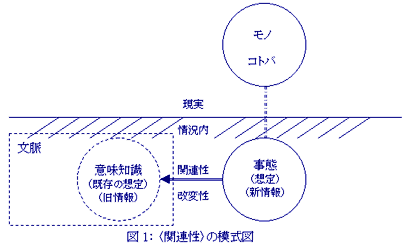本年度(3年計画の1年目)は、3つの研究方法(認知実験、脳波測定実験、シミュレーション実験)のうち、認知実験に焦点を当てた研究を主に行った。本経過報告書では、その概要を報告する。 研究目的情況との《辻褄合わせ》とは、いったいどういうことなのであろうか。この概念は、深谷・田中(1996)が展開する「意味づけ論」の重要なものの一つであり、スペルベル・ウィルソン(1986)の「関連性の原理」に近いものである。関連性の理論は、概略、人間の認知の仕方は関連性を最大化するように仕向けられているということと、意図伝達行為はそれが最適の関連性を含むということを同時に伝達するということの2点を強調するものである。これに「主体による意味調整という積極的働きかけ」をかぶせ、「人は、連接を可能にする関連性を、意味づけの調整をしながら、見出そうとする傾向を持っている」というのが「辻褄合わせの原理」である。では、この辻褄合わせは、どの様に図られるのであろうか。本研究では、①意図把握(後述)に焦点をあてながら、この問題を実証的に研究すること、②辻褄合わせの認知メカニズムのモデル化を図ること、この2つを目的としたい。 研究内容そもそも、《関連性》とはどのような概念なのであろうか。それは概略、既存の想定がいかに改変されていくのかということに関する概念であり、意味づけ論で言うところの《情況編成》の概念に近いものである。これを図示すると、図1のようになる。  ここで、スペルベル・ウィルソン(1986: 147, 151)が示している《関連性》の定義を挙げておこう。
文脈とは、心理的な構成概念であり、世界についての聞き手の想定の部分集合のようなものである。また文脈化とは、新情報と旧情報との結合に基づいた演繹のことであり、意味づけ論で言うところの《事態構成》の概念に近いものである。そして文脈効果とは、その文脈に何らかの効果を与えること、つまり新旧情報間の相互作用の結果生じるものである。 次に、関連性理論の強調点について見てみよう。一つ目は、「人間の認知の仕方は関連性を最大化するように仕向けられている」という人間の認知に関するものであり、聴者の理論を展開している部分である。二つ目は、「意図伝達行為はそれが最適の関連性を含むということを同時に伝達する」というコミュニケーションに関するものであり、伝達者の理論を展開している部分である。ここでのキーワードは《意図明示推論的伝達》であるが、それは聴者にとって関連性があるように思えるようにしようと意図していなければならない、という点を強調している。 研究成果
認知実験に関するもの。本研究の手始めとして、認知実験の結果を報告した。
This study is basically concerned with crosslinguistic semantics as being represented in second language learners. More specifically, we focus on how Japanese learners of English interpret metaphorical expressions in Japanese and English. As suggested by Black (1962), Lakoff (1987), and Johnson (1987), the basic structure of metaphorical expressions is A IS B as in "An argument is a war," "Love is a Journey," and "A theory is a building." The values of A and B are both nouns, and yet, the semantic structure of nouns differ in nature according to the type of nouns. This, in turn, implies that interpretations of metaphors differ depending on which nouns fill in the slots of A and B. In this study, we conduct two experiments. In experiment 1, we select four types of nouns: object nouns (e.g., apple), collective nouns (e.g., furniture), person nouns (e.g., businessman), and abstract nouns (e.g., justice). Association tests (using computers) are carried out with both Japanese nouns and their English equivalents in order to explore the semantic structure of each noun. The subjects are 90 university students, who are grouped into three English proficiency groups on the basis of the scores on TOEFL. In experiment 2, using the nouns in experiment 1, metaphorical expressions of A IS B (e.g., Businessmen are birds) are produced both in English and Japanese, and the same 90 students are to be asked to interpret each expression. Their interpretations are carefully examined with reference to the results in experiment 1. We discuss the results of this study, with reference to semantic transfer, prototype effects, and the process of sense-making.
The purpose of this study is to show on an empirical basis how sense-making of verbal expressions co-occurs with context formation. In the first section, we would first to explain the theoretical framework assumed in this study and research questions. The second section describes the methods of this study, and the final section briefly shows the results and discussion. The questionnaire consisted of 10 cases. For each case, an utterance and its contextual information were give and then four questions were asked. The first three question (1-3) are presented in order to capture the on-going process of context formation. The same procedures were used for the remaining 9 cases. The questionnaire had two types (type A and Type B), of which the difference lied in the order of presenting contextual information. The questionnaire was presented on a computer screen. The subjects participated in this study were 252 university students in total. These subjects were divided two groups (126 for each group). Each group answered somewhat different questionnaire (either type A or type B). We discuss the results of this study: First, the interpretation of an utterance did change as contextual information was added successively. Overall, however, we found no cumulative effects on context formation. In other words, the subjects formed their own contexts every time a new piece of information was given.
And finally, there were some patterns in responding. If faced with conflicting situation, the subjects tended to employ a "play-it-safe" strategy. |